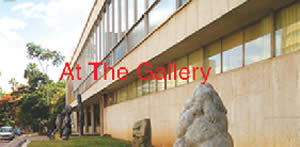Mobility in African contemporary art

The “Kabbo ka Muwala” exhibition will be opening this month, featuring 20 artists from East and Southern Africa. The central theme of the exhibition is “Migration”, herein the artists address the theme while mirroring their own experiences whilst coupling these with contemporary overall issues.
The content brought forth is brutally frank; highly attentive and responsive to pertinent affairs, vivid in its descriptive accounts and incisive on a matter that is generally overlooked as an aspect of human nature.
The nomadic nature of human beings, regardless of what circumstances lead to the shift from one area to another, lies at the core of “Kabbo ka Muwala’s” main thrust and etymology of the concept is metaphorically applied as “The Girl’s Basket”.
The metaphor is embodied within the dowry, which a girl carries with her when she moves to her husband’s home.
The personal details of this shift after an identity changing life event such as marriage, is expressive of how the motions the migration across borders affect the migrant; a complete overhaul of thought and conception need to be made, albeit to a new Culture and national philosophy.
Relating to identity and the migrant, socio-economic and political factors are the main drivers of migration. The important aspect of readjustment to a new scene is predominantly built up by a sense of community in the country the migrants are travelling to, the case being often based on “tribal” grounds. In their paper, “Somewhere Else: Social Connection and Dislocation of Ethiopians in Johannesburg”, Tanya Zack and Yordanis Seifu Estifanis point out the crisis of expectation that the individual experiences in their home country, viewing the host-to-be country as some sort of El Dorado, to such a point that they abort their education to make this mammoth leap into the invariably unknown.
Such is ever present in Gerald Machona’s body of work shown at “All the World’s Futures”, the theme of the 2015 Venice Biennale; whereby his sculpture “Ndiri Afronaut” (I am an Afronaut) touched the daily experiences of the ordinary Zimbabwean’s exploits in a foreign land. Though there are differences in the parallel Ethiopian example set by Zack and Estifanis, (wherein a majority of Ethiopian migrants have a socio-economic drive to their excursions) the Zimbabwean excursion is highly individualistic and is thrust towards seeking ‘quality’ education.
The sculpture was an extravehicular mobile unit made out of decommissioned Zimbabwean Bearer Cheques (a form of currency that was created to curb the hyperinflationary surge of the early 2000s) which emphasises the advanced reason behind the shift made by most Zimbabweans who emigrated to South Africa.
The combination of social, economic and political shifts presents, through this example of Machona’s work, the crippling individual experience that burdens most migrants without any sense of community in the host nation. The Pan-African concept is shaken therein, the “Afronaut” mien itself bids service to exploration and discovery that has a quasi-scholastic leaning to it that is largely ravaged by the host nation’s insights of the presence of migrants and how these immigrants “potentially” or practically threaten the order within their domain.
In as much as the opinion that war has been present on the continent, the ancient trade routes between Southern and East Africa are completely overlooked in this day in age. Empires such as the Monomotapa or Zanj had links which were evidently well established and eventually led to several groups from the region settling in completely far flung host nations.
Moreover is the fact that long after Iron Age regional trade, an organization in the form of COMESA exists, with knowledge of this complex trade network from yesteryear, which was deeply rooted in migration.
The migratory nature of the people in the East and Southern African region (as was elsewhere on the continent) was disrupted by the Berlin Conference of 1884-85. Naturally, new definitions of trade, limitations, and language as well as “new” identities were created with the drawing of borders between societies that had mutually existed for thousands of years.
Migration and mobility in the present day may also be influenced by this indoctrination and assimilation of Western constructs; an adopted economy both in power and ideology is bound to preach that might is indeed right as opposed to the region’s intrinsic practice of Ubuntu/Unhu. The latter concept could be well developed into a socio-economic or political principle, whereas the experiential onus upon the migrant is cancelled out by a universal philosophy.
An outreach programme was made to the country’s biggest refugee camp, Tongogara; to get a first hand detail of the plight of the migrants who are residing in this community. It was recognised that an assemblage of artists of different ages practising within the camp and the communities immediately around it.
Artists featured include Berry Bickle (ZW), Jodi Bieber (ZA), The Border Farm Project (ZW/ZA), Rehema Chachage (TZ), Mimi Cherono Ng’ok (KE), Kudzanai Chiurai (ZW), Anawana Haloba (ZM/NO), Kiluanji Kia Henda (AO), Wanja Kimani (KE/ET/UK), Miriam Syowia Kiambi (KE), Gerald Machona (ZW/ZA), Immy Mali (UG), Nástio Mosquito (AO), Victor Mutelekesha (ZM/NO), MwangwiHutter (DE/KE), NakivArt/Anke Fischer (UG/DE), Emma Wolukau-Wanambwa (UG/UK), Xenson (UG), Helen Zeru (ET) and Rut Karin Zettergren (SE).
The exhibition’s curators are Raphael Chikukwa (National Gallery of Zimbabwe), Katrin Peters-Klaphake (Makerere Art Gallery) and Dr Ingmar Lähnemann (Städtische Galerie Bremen. Anna Ku?ma (Makerere Art Gallery) serves as assistant curator.
“Kabbo ka Muwala: The Girl’s Basket” will be open to the general public on Friday February 5, at the National Gallery of Zimbabwe in Harare. “Kabbo ka Muwala; The Girl’s Basket” is sponsored by the United Nations High Commission for Refugees (UNHCR) and the British Council.









Comments